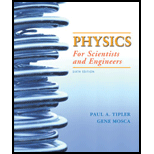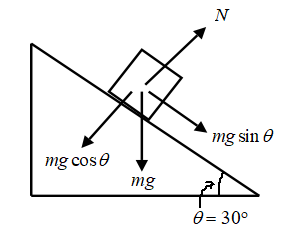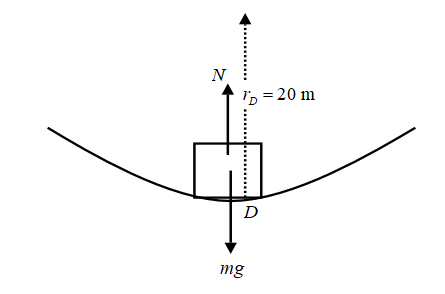
Concept explainers
(a)
The height of point B above the ground, if the car at A barely makes it up the hill at B.
(a)
Answer to Problem 97P
The point B is at a height of
Explanation of Solution
Given:
The mass of the roller- coaster carriage
Speed at point A
Height of A above the ground
Formula used:
The carriage at A has both potential and kinetic energies.
However, the carriage just manages to make it over the point B . This means that at B the carriage has no kinetic energy, it has potential energy alone by virtue of its position.
Therefore, the energy at B is given by,
Apply the law of conservation of energy to the motion of the carriage between points A and B .
Therefore,
Hence,
Calculation:
Substitute the values of the variables in equation (1).
Conclusion:
Thus, the point B is at a height of
(b)
The magnitude of the force exerted by the track on the car if it is just able to make it over the hill at B .
(b)
Answer to Problem 97P
Explanation of Solution
Given:
The mass of the roller- coaster carriage
Radius of curvature of the hill located at B .
Formula used:
The car crosses over a hill of radius of curvature
provides the centripetal force. This is shown in Figure 1, below:

Figure 1
Thus, the force exerted by the track on the car is the centripetal force and this is equal to the weight of the car.
Calculation:
Substitute the given values of the variables in equation (2).
Conclusion:
Thus, the magnitude of the force exerted by the track on the car at point B is found to be
(c)
The acceleration of the car at point C .
(c)
Answer to Problem 97P
Explanation of Solution
Given:
The angle of the incline
Formula used:
The point C is on an incline and when no dissipative forces act on the car, the car moves down with a constant acceleration. Modelling the motion of the car at point C as that over an incline, the free body diagram of the car is drawn.

Figure 2
The car is under the action of two forces: (i) the weight
Since the block is in equilibrium along the direction perpendicular to the incline,
However, the component
Hence,
Calculation:
Substitute the values of the variables in equation (3) and calculate the value of the acceleration at point C .
Conclusion:
Thus, the acceleration of the car at point C is found to be
(d)
The force exerted by the track on the car at point D .
(d)
Answer to Problem 97P
The force exerted by the track on the car at point D is found to be
Explanation of Solution
Given:
The mass of the roller- coaster carriage
Radius of curvature of the valley located at D .
Height of point B above the ground
Formula used:
The point D is located at the ground level. Assuming the car has zero velocity at B , its energy is entirely potential at B . This energy is converted into kinetic energy at D .
Using the law of conservation of energy
At D the car traces an arc of radius

Figure 3
The car is acted upon by two forces- (i) Its weight
The total inward force provides the centripetal force, which is given by the expression
Therefore,
Hence,
From equation (4),
Equation (5), therefore can be simplified as follows:
Therefore,
Calculation:
Substitute the values of the variables in equation (6).
Conclusion:
Thus, the force exerted by the track on the car at point D is found to be
(e)
The magnitude and the direction of the force exerted by the track at the point F which lies in the middle of a banked horizontal curve of radius 30 m.
(e)
Answer to Problem 97P
The magnitude of the force exerted by the track on the car is
Explanation of Solution
Given:
The mass of the roller- coaster carriage
Height of point F above the ground
Radius of curvature of the path at F
Speed at point A
Formula used:
The car is at the same height as point A . The system is under the action of gravitational forces alone. Hence the speed at F is equal to the speed at A .
The car is on a horizontal banked road. The forces acting on the car are shown in Figure 4.

Figure 4
The forces acting on the car are (i) weight
The normal force N is resolved into two components-
The car is in equilibrium along the y direction.
Therefore,
The component
The force exerted by the track on the car is given by,
The angle made by the force N with the horizontal is given by,
Calculation:
Substitute the values of the variables in equation (7) and calculate the value of
Substitute the values of the variables in equation (8) and calculate the value of
Substitute the values of the variables in equation (9) and calculate the magnitude of the force exerted by the track on the car.
Calculate the angle made by the force with the horizontal using equation (10).
Conclusion:
Thus, the magnitude of the force exerted by the track on the car is
(f)
The magnitude of the braking force that needs to be applied at G so that the car comes to rest in a distance of 25 m.
(f)
Answer to Problem 97P
The magnitude of the braking force that needs to be applied at G so that the car comes to rest in a distance of 25 m is
Explanation of Solution
Given:
The mass of the roller-coaster carriage
Speed at point A
Distance travelled before stopping
The final velocity of the car
Formula used:
The point G is at the same height as points F and A . Therefore, the speed at G is equal to the speed at A .
The acceleration of the car is determined using the expression,
The braking force can be determined using Newton’s second law:
Calculation:
Substitute the values of the variables in equation (11) and calculate the acceleration at G .
The negative sign shows that the acceleration is directed opposite to the car’s velocity.
Calculate the braking force using equation (12).
Conclusion:
Thus, the magnitude of the braking force that needs to be applied at G so that the car comes to rest in a distance of 25 m is
Want to see more full solutions like this?
Chapter 7 Solutions
Physics For Scientists And Engineers
- Two blocks, A and B (with mass 50.0 kg and 1.00 102 kg, respectively), are connected by a string, as shown in Figure P5.86. The pulley is frictionless and of negligible mass. The coefficient of kinetic friction between block A and the incline is k = 0.250. Determine the change in the kinetic energy of block A as it moves from to , a distance of 20.0 m up the incline (and block B drops downward a distance of 20.0 m) if the system starts from rest. Figure P5.86arrow_forwardA 60.0-kg skier with an initial speed of 12.0 m/s coasts up a 2.50-m high rise as shown. Find her final speed at the top, given that the coefficient of friction between her skis and the snow is 0.80.arrow_forwardConsider a particle on which a force acts that depends on the position of the particle. This force is given by . Find the work done by this force when the particle moves from the origin to a point 5 meters to the right on the x-axis.arrow_forward
- Suppose that the sled plus passenger of the preceding problem is pushed 20 m across the snow at constant velocity by a force directed 30 below the horizontal. Calculate (a) the work of the applied force, (b) the work of fiction, and (c) the total work.arrow_forwardAt the bottom of an air track tilted at angle , a glider of mass m is given a push to make it coast a distance d up the slope as it slows down and stops. Then the glider comes back down the track to its starting point. Now the experiment is repeated with the same original speed but with a second identical glider set on top of the first. The airflow from the track is strong enough to support the stacked pair of gliders so that the combination moves over the track with negligible friction. Static friction holds the second glider stationary relative to the first glider throughout the motion. The coefficient of static friction between the two gliders is s. What is the change in mechanical energy of the two-glider-Earth system in the up- and down-slope motion after the pair of gliders is released? Choose one. (a) 2smg (b) 2mgd cos (c) 2smgd cos (d) 0 (e) +2smgd cosarrow_forwardA child of mass m starts from rest and slides without friction from a height h along a curved waterslide (Fig. P5.46). She is launched from a height h/5 into the pool. (a) Is mechanical energy conserved? Why? (b) Give the gravitational potential energy associated with the child and her kinetic energy in terms of mgh at the following positions: the top of the waterslide, the launching point, and the point where she lands in the pool. (c) Determine her initial speed V0 at the launch point in terms of g and h. (d) Determine her maximum airborne height ymax in terms of h, g, and the horizontal speed at that height, v0x. (e) Use the x-component of the answer to part (c) to eliminate from the answer to part (d), giving the height ymax in terms of g, h, and the launch angle . (f) Would your answers be the same if the waterslide were not frictionless? Explain. Figure P5.46arrow_forward
- Repeat the preceding problem, but this time, suppose that the work done by air resistance cannot be ignored. Let the work done by the air resistance when the skier goes from A to B along the given hilly path be —2000 J. The work done by air resistance is negative since the air resistance acts in the opposite direction to the displacement. Supposing the mass of the skier is 50 kg, what is the speed of the skier at point B ?arrow_forwardThe same constant force is used to accelerate two caritos of equal masses, initially at rest on a horizontal surface without friction. The force is applied to cart A for twice as long as the duration applied to cart B. The work done on body A is WA ; and the one performed on B is WB . Which of the following statements is correct?arrow_forwardAnswer A and B for question 2 2. An object was a mass of 10.0 kg is at rest at the top of a frictionless inclined plane of length 8.00 m and an angle of inclination 30.0° with the horizontal. The object is released from this position and it stops at a distance d from the bottom of the inclined plane along a horizontal surface, as shown in Fig. 8-6. The coefficient of kinetic friction for the horizontal surface of 0.400. (a) What is the speed of the object at the bottom of the inclined plane? (b) At what horizontal distance from the bottom of the inclined plane will this object stop?arrow_forward
- An Olympic swimmer stands on top of a platform at a height H above a swimming pool. At the moment of jumping into the pool, he jumps with a speed v_0 forming an angle θ with the horizontal, just as shown in the figure. The swimmer reaches a maximum height h measured from the platform to point B. (d) If we assume that when entering the water the athlete follows a straight path traveling 3.50 m before coming to a complete stop in the water and that the frictional force exerted by the water is 206 N. Determine the change in mechanical energy that the athlete experiences when stopping in the waterarrow_forwardA ball of mass 0.300 kg is thrown upward, rising 10.0 m above the point at which it was released. Compute the average force exerted on the ball by the hand, if the hand moves through a distance of 20.0 cm as the ball is accelerated.arrow_forwardA 380-kg piano slides 2.9 m down a 25o incline and is kept from accelerating by a man who is pushing back on it parallel to the incline (Fig. 6-36) Determine: (a) the force exerted by the man, (b) the work done on the piano by the man, (c) the work done on the piano by the force of gravity, and (d) the net work done on the piano. Ignore friction.arrow_forward
 University Physics Volume 1PhysicsISBN:9781938168277Author:William Moebs, Samuel J. Ling, Jeff SannyPublisher:OpenStax - Rice University
University Physics Volume 1PhysicsISBN:9781938168277Author:William Moebs, Samuel J. Ling, Jeff SannyPublisher:OpenStax - Rice University College PhysicsPhysicsISBN:9781285737027Author:Raymond A. Serway, Chris VuillePublisher:Cengage Learning
College PhysicsPhysicsISBN:9781285737027Author:Raymond A. Serway, Chris VuillePublisher:Cengage Learning Principles of Physics: A Calculus-Based TextPhysicsISBN:9781133104261Author:Raymond A. Serway, John W. JewettPublisher:Cengage Learning
Principles of Physics: A Calculus-Based TextPhysicsISBN:9781133104261Author:Raymond A. Serway, John W. JewettPublisher:Cengage Learning


